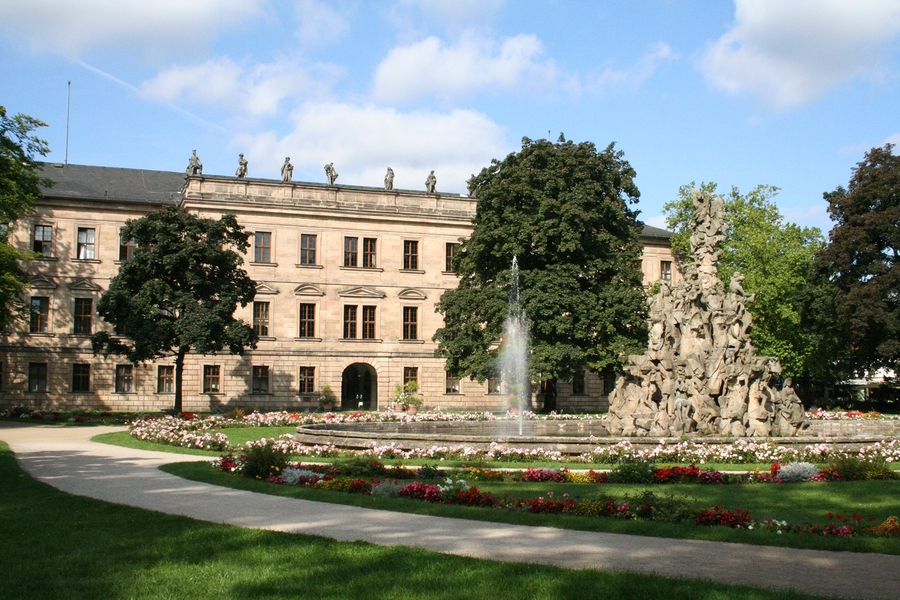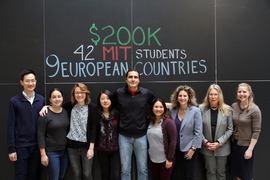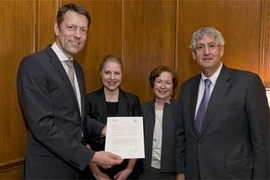The MIT-Germany Program, a part of the MIT Science and Technology Initiatives (MISTI), which connects students and faculty members with research and industry partners abroad, recently began a new partnership with the Friedrich Alexander University of Erlangen-Nürnberg (FAU). FAU, currently celebrating its 275th year, is one of the largest universities in Germany, with strong research programs in engineering and technology.
The new partnership is multifaceted. For students, it enables new student internship placements and expands the Global Teaching Labs program to Erlangen and Nürnberg, with both MIT and FAU participants. For faculty, the partnership creates a new MIT-FAU Seed Fund, which will finance collaborative early stage research projects as part of the MISTI Global Seed Funds program. Additional activities, including an annual workshop, will help to cement further faculty and student collaboration between the two universities.
Founded in 1997, the MIT-Germany Program is one of the largest MISTI programs, sending an average of 80 to 100 students each year. Justin Leahey, MIT-Germany Program manager, says student interest for internships in Germany continues to rise, given the high quality of tailored projects with top German partners. “Our students have already had great research internships at FAU itself,” Leahey says. “But FAU’s strong ties to local industry, including the innovative ‘Medical Valley’ cluster, afford new opportunities.”
“I am very excited about this new opportunity for MIT faculty, students, postdocs and staff to make connections with Germany. As the MIT-Germany program grows, many new opportunities for collaborations will emerge, and create synergies between FAU and MIT, spanning the spectrum from teaching to cutting edge research,” says Professor Markus Buehler, MIT-Germany faculty director and head of the Department of Civil and Environmental Engineering.
Bjoern Eskofier, professor of computer science at FAU and current visiting professor at the MIT Media Lab, agrees. “In Germany, we say we have a lot of ‘hidden champions.’” He explains that this refers to companies comprised of less than 500 employees that form the backbone of the German economy. “A lot of them are world market leaders in a really small niche, but nobody can surpass them because of their high quality,” he says. “We call them the ‘Deutscher Mittelstand’ [roughly equivalent to ‘small and medium-sized enterprises’]. I would say that my university is also one of those hidden champions.” While some outside Europe may not immediately be able to place his home university, he points out that FAU has been ranked by Reuters this year as the most innovative university in Germany and number 5 in all of Europe.
“MIT is one of the worldwide leading institutions in engineering sciences and other disciplines, so it’s just logical for us to try to work with the best out there,” Eskofier says. FAU is especially strong in medical and engineering research, with its engineering faculty ranking as one of the three strongest in Germany. Pointing to FAU’s scientific core areas, including medical engineering, life sciences and health, new materials and processes, and information technology, he adds, “This is just a perfect match for things that are also in focus [at MIT].” As the head of the Machine Learning and Data Analytics Lab at FAU, Eskofier is currently collaborating with the MIT Media Lab in machine learning, wearable computing, and human-computer interaction groups.
Bringing researchers from different countries together with varying but overlapping sets of expertise is fruitful in both directions, Eskofier says. The research he is involved in at the Media Lab revolves around social network badges, a project driven by Oren Lederman of the Human Dynamics research group. The group is working on a wearable computing device that measures social interactions, closeness and audio pitch of people in work environments. “It brings up questions like, [do] men more often interrupt women in a meeting scenario?” says Eskofier, explaining the potential applications of this research collaboration back in Germany for The World of Work, another one of FAU’s scientific core areas.
Eskofier hopes to leverage the many complementary projects at FAU and MIT. One familiar challenge that most German university hospitals face is making health care data accessible for research without putting personal data protection and privacy at risk. Researchers at MIT work on a system called Open Algorithms (OPAL), and Eskofier is exploring strategies to make this useful in Germany. This is the type of knowledge sharing and exchange made possible when two universities collaborate through partnerships like the MIT-Germany-FAU cooperation.
In addition to the excellent researchers and facilities at FAU, Eskofier notes the strong embedding in German local and national industry that allows MIT-Germany students to receive exposure to industry projects, including within the automotive and medical technology fields. The German emphasis on having a balanced work-life culture also lends itself to a positive professional experience for students. “That’s a magic secret we only show to visitors that experience it [first-hand],” Eskofier jokes about the high productivity in the German workplace, despite often working fewer hours than Americans.
Last summer, MIT-Germany student Tyndale Hannan worked on a physics project with the Department of Computer Science at FAU. “My mentor would occasionally take a break from work with me to sit down and discuss future prospects in the field of laser physics,” says Hannan. “These talks were invaluable guidance. Overall, working at FAU was a fun and formative experience that opened doors to more opportunities in research.” This summer, the rising junior is now working as a Physics Research Fellow at the University of California at San Diego.
“There is nothing better than to send students away and to hire them again later because they were just immersed in a different scientific culture,” Eskofier says of his FAU students who have brought new skills back from international research experiences. He notes that such opportunities are good for personal development, and that they return from their experience more enriched and full of ideas.
As a visiting professor himself at MIT, Eskofier cites the obvious appeal for FAU students and researchers to come to MIT, and is excited about the bridge that this new partnership has opened up to receive MIT students at FAU. “They will benefit because it’s always good to have exposure to different ideas, skillsets, and mindsets. We have a different way of working and it’s also very competitive and motivating,” he says.
The framework for the new cooperation outlines the current global engagement at FAU focusing on “promoting an increasingly diverse culture of internationalization through complementary strategic institutional measures” with the main goal of expanding and promoting international research collaborations, giving way to greater visibility worldwide. This aligns well with the mission of the MIT-Germany Program and MISTI, which is a part of the Center for International Studies within the School of Humanities, Arts, and Social Sciences. Leahey says, “We’re looking forward to a productive partnership that will benefit students and faculty at both universities.”








